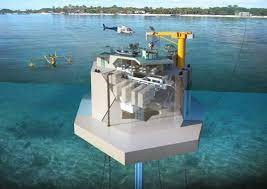OTEC – what is and why should we consider it?
There is a new but old technology making its way around the green energy discussions. I'm referring to Ocean Thermal Energy Conversion (OTEC). The technology has been understood since the 1800s, but it wasn't until the last 15 years that significant advancements were made and are currently being developed for improved designs.
What exactly is OTEC, and how does it work? In a nutshell, it is the use of the temperature difference between the surface and the deeper parts of the ocean to heat and cool a working fluid (usually ammonia). Because the working fluid has a low boiling point, there is no need for a significant temperature difference; it should be at least 20°C. The working fluid is then heated using surface ocean water, causing it to turn into vapor pressure, which is used to drive the generator turbines, allowing electricity to flow. The vapor is then condensed back into liquid form by cooling with deep ocean water. As a result, the cycle continues to produce a steady output of electrical energy. Aside from electricity, OTEC stations can generate two other byproducts: hydrogen and water. Hydrogen (H2) will be the clean fuel of the future, and water (H20) is the main source of life. So, with a single OTEC station, you have four products: electricity, hydrogen, fresh water and a continuous supply of clean, nutrient rich and very cold seawater. The latter can be used for Sea Water Air Conditioning (SWAC) and aquaculture. The vapor is then condensed back into liquid form by cooling with deep ocean water. As a result, the cycle continues to produce a steady output of electrical energy. Aside from electricity, OTEC stations can generate two other byproducts: hydrogen and water. Hydrogen (H2) will be the clean fuel of the future, and water (H20) is the main source of life. So, with a single OTEC station, you have four products: electricity, hydrogen, fresh water and a continuous supply of clean, nutrient rich and very cold seawater. The latter can be used for Sea Water Air Conditioning (SWAC) and aquaculture.
You're probably
thinking by now, "this is too good to be true or OK, but what's the catch?"
Well, it only works if you're geographically close to the equator, have easy
access to very deep seawater and it doesn't work in colder locations. That's
hardly a disadvantage for us; in fact, it's an advantage. This is why, together
with solar, hydro, and wind, it is likely one of the best renewable
technologies for the Pacific region. If anything, it is well worth
contemplating a hybrid electrical system that combines all four, supplying
enough to provide the majority of our electrical demand, particularly in
low-lying islands and rural areas. And if we can produce surplus renewable electricity,
then we are on the track to being able to make our own hydrogen.
This isn't to argue
that OTEC is a perfect technology. It has limitations, just like any other. But
all research shows the potential, especially for the atoll nations such as my
own. We still have work to do to bring this technology to maturity. Most previous
attempts at OTEC in the past have failed primarily on the economic side, and
everyone has been afraid to even consider it. Our partners at KRISO in Korea led this work
internationally and are preparing a 1-MW trial plant in Kiribati as I write. At MCST we are now preparing for the Marshall
Islands first demonstration plant. A few
of us are hard at work to understand the real potential, costs and benefits of
this technology, and I expect the rest of us in the Pacific region will consider
following suit. It is time to take action and practice what we preach and move
towards a renewable and sustainable future.






Comments
Post a Comment